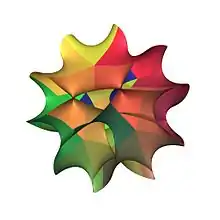Siegel modular variety
In mathematics, a Siegel modular variety or Siegel moduli space is an algebraic variety that parametrizes certain types of abelian varieties of a fixed dimension. More precisely, Siegel modular varieties are the moduli spaces of principally polarized abelian varieties of a fixed dimension. They are named after Carl Ludwig Siegel, the 20th-century German number theorist who introduced the varieties in 1943.[2][3]

Siegel modular varieties are the most basic examples of Shimura varieties.[4] Siegel modular varieties generalize moduli spaces of elliptic curves to higher dimensions and play a central role in the theory of Siegel modular forms, which generalize classical modular forms to higher dimensions.[1] They also have applications to black hole entropy and conformal field theory.[5]
Construction
The Siegel modular variety Ag, which parametrize principally polarized abelian varieties of dimension g, can be constructed as the complex analytic spaces constructed as the quotient of the Siegel upper half-space of degree g by the action of a symplectic group. Complex analytic spaces have naturally associated algebraic varieties by Serre's GAGA.[1]
The Siegel modular variety Ag(n), which parametrize principally polarized abelian varieties of dimension g with a level n-structure, arises as the quotient of the Siegel upper half-space by the action of the principal congruence subgroup of level n of a symplectic group.[1]
A Siegel modular variety may also be constructed as a Shimura variety defined by the Shimura datum associated to a symplectic vector space.[4]
Properties
The Siegel modular variety Ag has dimension g(g + 1)/2.[1][6] Furthermore, it was shown by Yung-Sheng Tai, Eberhard Freitag, and David Mumford that Ag is of general type when g ≥ 7.[1][7][8][9]
Siegel modular varieties can be compactified to obtain projective varieties.[1] In particular, a compactification of A2(2) is birationally equivalent to the Segre cubic which is in fact rational.[1] Similarly, a compactification of A2(3) is birationally equivalent to the Burkhardt quartic which is also rational.[1] Another Siegel modular variety, denoted A1,3(2), has a compactification that is birationally equivalent to the Barth–Nieto quintic which is birationally equivalent to a modular Calabi–Yau manifold with Kodaira dimension zero.[1]
Applications
Siegel modular forms arise as vector-valued differential forms on Siegel modular varieties.[1] Siegel modular varieties have been used in conformal field theory via the theory of Siegel modular forms.[10] In string theory, the function that naturally captures the microstates of black hole entropy in the D1D5P system of supersymmetric black holes is a Siegel modular form.[5]
In 1968, Aleksei Parshin showed that the Mordell conjecture (now known as Faltings's theorem) would hold if the Shafarevich finiteness conjecture was true by introducing Parshin's trick.[11][12] In 1983 and 1984, Gerd Faltings completed the proof of the Mordell conjecture by proving the Shafarevich finiteness conjecture.[13][14][12] The main idea of Faltings' proof is the comparison of Faltings heights and naive heights via Siegel modular varieties.[15]
References
- Hulek, Klaus; Sankaran, G. K. (2002). "The Geometry of Siegel Modular Varieties". Higher Dimensional Birational Geometry. Advanced Studies in Pure Mathematics. Vol. 35. pp. 89–156. arXiv:math/9810153. doi:10.2969/aspm/03510089. ISBN 978-4-931469-85-3. S2CID 119595519.
- Oda, Takayuki (2014). "Intersections of Two Walls of the Gottschling Fundamental Domain of the Siegel Modular Group of Genus Two". In Heim, Bernhard; Al-Baali, Mehiddin; Rupp, Florian (eds.). Automorphic Forms, Research in Number Theory from Oman. Springer Proceedings in Mathematics & Statistics. Vol. 115. Springer. pp. 193–221. doi:10.1007/978-3-319-11352-4_15. ISBN 978-3-319-11352-4.
- Siegel, Carl Ludwig (1943). "Symplectic Geometry". American Journal of Mathematics. The Johns Hopkins University Press. 65 (1): 1–86. doi:10.2307/2371774. JSTOR 2371774.
- Milne, James S. (2005). "Introduction to Shimura Varieties" (PDF). In Arthur, James; Ellwood, David; Kottwitz, Robert (eds.). Harmonic Analysis, the Trace Formula, and Shimura Varieties. Clay Mathematics Proceedings. Vol. 4. American mathematical Society and Clay Mathematics Institute. pp. 265–378. ISBN 978-0-8218-3844-0.
- Belin, Alexandre; Castro, Alejandra; Gomes, João; Keller, Christoph A. (11 April 2017). "Siegel modular forms and black hole entropy" (PDF). Journal of High Energy Physics. 2017 (4): 57. arXiv:1611.04588. Bibcode:2017JHEP...04..057B. doi:10.1007/JHEP04(2017)057. S2CID 53684898. See Section 1 of the paper.
- van der Geer, Gerard (2013). "The cohomology of the moduli space of Abelian varieties". In Farkas, Gavril; Morrison, Ian (eds.). The Handbook of Moduli, Volume 1. Vol. 24. Somerville, Mass.: International Press. arXiv:1112.2294. ISBN 9781571462572.
- Tai, Yung-Sheng (1982). "On the Kodaira dimension of the moduli space of abelian varieties". Inventiones Mathematicae. 68 (3): 425–439. Bibcode:1982InMat..68..425T. doi:10.1007/BF01389411. S2CID 120441933.
- Freitag, Eberhard (1983). Siegelsche Modulfunktionen. Grundlehren der mathematischen Wissenschaften (in German). Vol. 254. Springer-Verlag. doi:10.1007/978-3-642-68649-8. ISBN 978-3-642-68650-4.
- Mumford, David (1983). "On the Kodaira dimension of the Siegel modular variety". In Ciliberto, C.; Ghione, F.; Orecchia, F. (eds.). Algebraic Geometry - Open Problems, Proceedings of the Conference held in Ravello, May 31 - June 5, 1982. Lecture Notes in Mathematics. Vol. 997. Springer. pp. 348–375. doi:10.1007/BFb0061652. ISBN 978-3-540-12320-0.
- Belin, Alexandre; Castro, Alejandra; Gomes, João; Keller, Christoph A. (7 November 2018). "Siegel paramodular forms and sparseness in AdS3/CFT2". Journal of High Energy Physics. 2018 (11): 37. arXiv:1805.09336. Bibcode:2018JHEP...11..037B. doi:10.1007/JHEP11(2018)037. S2CID 54936474.
- Parshin, A. N. (1968). "Algebraic curves over function fields I" (PDF). Izv. Akad. Nauk. SSSR Ser. Math. 32 (5): 1191–1219. Bibcode:1968IzMat...2.1145P. doi:10.1070/IM1968v002n05ABEH000723.
- Cornell, Gary; Silverman, Joseph H., eds. (1986). Arithmetic geometry. Papers from the conference held at the University of Connecticut, Storrs, Connecticut, July 30 – August 10, 1984. New York: Springer-Verlag. doi:10.1007/978-1-4613-8655-1. ISBN 0-387-96311-1. MR 0861969.
- Faltings, Gerd (1983). "Endlichkeitssätze für abelsche Varietäten über Zahlkörpern" [Finiteness theorems for abelian varieties over number fields]. Inventiones Mathematicae (in German). 73 (3): 349–366. Bibcode:1983InMat..73..349F. doi:10.1007/BF01388432. MR 0718935. S2CID 121049418.
- Faltings, Gerd (1984). "Erratum: Endlichkeitssätze für abelsche Varietäten über Zahlkörpern". Inventiones Mathematicae (in German). 75 (2): 381. doi:10.1007/BF01388572. MR 0732554.
- "Faltings relates the two notions of height by means of the Siegel moduli space.... It is the main idea of the proof." Bloch, Spencer (1984). "The Proof of the Mordell Conjecture" (PDF). The Mathematical Intelligencer. 6 (2): 44. doi:10.1007/BF03024155. S2CID 306251. Archived from the original (PDF) on 2019-03-03.